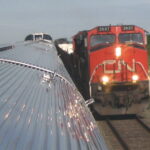CSX To Be Called on the Carpet.
Congestion and delays on the CSX network are continuing. The FRA’s Surface Transportation Board describes it as “widespread degradation of rail service” and the CSX brass are being formally summoned to a public hearing and asked to explain.
The STB will be holding a formal hearing into the situation and among those testifying will be Jim Mathews, NARP’s President and CEO. In an email to the NARP membership, Mathews asked for any first-hand experiences that will illustrate the “human cost” that results when the on-time performance of passenger trains become a joke.
A number of Amtrak trains operate on track owned and maintained by CSX. I’ve listed several of them below, along with their on time performance for the month of August. The OTP can vary significantly depending on each train’s direction, but I’ve listed each train’s worst OTP since that’s the most relevant.
* Capitol Limited (Washington to Chicago) – 36.7%
* Cardinal (Chicago to New York) – 21.4%
* Lake Shore Limited (New York to Chicago) – 6.5%
* Lake Shore Limited (Boston to Chicago) – 22.2%
* Maple Leaf (Toronto to New York) – 54.6%
* Silver Star (Miami to New York) – 12.9%
* Silver Meteor (New York to Miami) – 22.6%
Yes, that’s a terrible record. But, to be fair, an accurate review of any railroad’s on time performance isn’t that simple. For instance, the numbers only tell us what percent of those trains arrived on time; they do not tell us how late all the other arrivals were. It makes no difference if the train arrives 40 minutes late today and four hours late tomorrow. They go into the official record simply as two late arrivals.
Furthermore, Amtrak has on time tolerances the same way the airlines do. For trains traveling over routes of more than 501 miles, the tolerance is 30 minutes. In other words, if the Lake Shore Limited arrives in Chicago 27 minutes past its scheduled arrival time, that’s considered to be an on time arrival.
Of course, Amtrak officials slice and dice these numbers even more, but if nothing else, these numbers do offer a clear illustration of just how poorly the CSX system has been performing. It will be very interesting to see what the Surface Transportation Board might uncover after digging deeper into all of the details.
Even more interesting: What, if anything, will they do about it?



